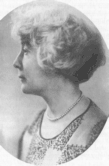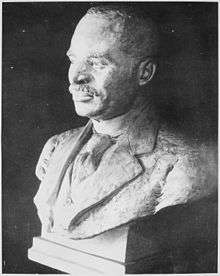May Howard Jackson
May Howard Jackson (September 7, 1877 – 1931) was an African American sculptor and artist. She was known as "one of the first black sculptors to...deliberately use America's racial problems" as the theme of her art.[1]
May Howard Jackson | |
|---|---|
 | |
| Born | September 7, 1877 |
| Died | 1931 |
| Nationality | American |
| Known for | Sculptor |
| Spouse(s) | William Sherman Jackson |
| Awards | Harmon Foundation, 1928 |
Early life and education
Early life
May Howard was born to a middle class couple, Floarda Howard and Sallie Durham, in Philadelphia on September 7, 1877.[2]
Education
Howard attended J. Liberty Tadd's Art School in Philadelphia, where she was trained with "new methods in education" that emphasized the use of visual arts and their importance in strengthening both the left and right sides of the brain. At the school she studied "drawing, designing, free-hand drawing, working designs in monochrome, modeling, wood carving, and the use of tools".
She then continued her avant-garde art training, with the support of a full scholarship, at the Pennsylvania Academy of the Fine Arts. In 1895, she became the first African American woman to attend PAFA, and she studied there for four years.[3] She studied under various artists including the renowned American Impressionist William Merritt Chase, Paris-trained academic sculptor Charles Grafly, and John Joseph Boyle (who had been a student of Thomas Eakins).
Career
After graduating, Howard met and married mathematics teacher and high school principal, William Sherman Jackson. He taught at Dunbar High School, the first public high school for African Americans. Here is where her sculpture of Paul Laurence Dunbar, done in 1919 and completed in bronze, resides. This bronze portrait has a textured, impressionistic surface.
In 1902, she moved to Washington D.C. She maintained her own home studio there, with an additional studio in New York, where she discussed her work with visitors. Aside from portrait sculpting, she spent two years teaching at Howard University as an art instructor (1922-1924). At the university she taught and influenced James Porter, who went on to write one of the first comprehensive histories of African-American art.[4] As an art historian, though, Porter was not impressed by her work and said that there was "no great originality in any of the pieces she attempted."[5]
At some point, Meta Warrick Fuller offered Jackson the chance to accompany her and study abroad. However, Jackson declined the invitation because she thought it was not necessary to travel to Europe to further her education.[4] As a result of not traveling in Europe, Jackson was somewhat isolated from her peers and was able to create her own vision that infused her work with a unique style. This style was ignored at first because it was so different from the popular style of the time.
Her style was seen as provocative because it explored the features of America's multiracial society. Though she had developed her own unique style, this style still adhered to academic tradition. Many galleries were not interested in her subject matter, as she dedicated most of her work to objective portraits of children, family members, and influential African Americans.[4]
Jackson exhibited at the Corcoran Gallery in Washington D.C. (1915), the Veerhoff Gallery in New York City (1919), and the National Academy of Design (1916, 1928). While exhibiting at the Veerhoff Gallery, she was reviewed by The Washington Star who wrote that Jackson's "work has always shown promise, but these pieces now on exhibit indicate exceptional gift, for they are not merely well modeled, but individual and significant".[4]
Jackson was also involved in the New Negro Movement which promoted a better understanding of African American culture. This influenced the subjects and style of her sculptures. Although she was known in Black Art circles, she was unable to sell her work and held a lifelong grudge against the art community, feeling unappreciated. Leslie King-Hammond, an art historian, later praised Jackson's "efforts to address...without compromise and without sentimentality, the issues of race and class, especially as they affected mulattos".[4]
Despite her talent, few galleries were willing to offer her exhibition space. With legal racial segregation in force across the South since the turn of the century, topics such as racial mixing were taboo in general. Laws against miscegenation had been proposed in both federal and state legislatures after Democrat Woodrow Wilson was elected as President in 1912.
Jackson's work and professional achievements were often overlooked, which left her feeling unappreciated. Though her work appeared time and time again in The Crisis and even on the cover as early as 1919, in 1929 she wrote, "I felt no satisfaction! Only deep sense of injustice, something that has followed me and my efforts all my life." In that same year, she won a coveted bronze medal and a one hundred dollar prize from the Harmon Foundation and had five works exhibited in the Harmon show. Two of these works were then illustrated in the catalogue, the works being "Kelly Miller", and "Head of a Negro Child".
Jackson's contributions to American art were not appreciated until after her death and the public's tepid response to her work weighed on her. W. E. B. Du Bois described her in a postscript as, "At once bitter and fierce with energy, cynical of praise and above all at odds with life and people..With her sensitive soul, she needed encouragement and contacts and delicate appreciation. Instead of this, she ran into the shadows of the Color Line...In the case of May Howard Jackson the contradictions and idiotic ramifications of the Color Line tore her soul asunder...She met rebuffs in her attempts to study and in her attempts at exhibition...in her chosen ideal of portraying the American mulatto type".[4]
Race
For centuries Europeans and Africans had formed unions and marriages. Though there is no proof that she was bi-racial, Jackson was known to have been mistaken for being Caucasian. Often, when people believed she was white she was treated very well, but when they discovered she was African American she was subjected to humiliating rebuffs. Jackson addresses the issues of identity in her work "Mulatto Mother and Child"(1929) where she responded to her "near-whiteness".
Jackson experienced a large amount of racism throughout her career. At one point, she applied for a membership to the Washington Society of Fine Arts. Although her application was initially accepted, it was later rejected when the society found out she was African American. The National Academy of Design sent someone to her home to ask if she was of "Negro blood" and from that point they decided not to allow any more of her work in future exhibits.[4]
Jackson expressed a fascination with the wide variety of features among African Americans and this became evident in her work. Pieces that expressed this love are works such as "Head of a Negro Child" (1916), "Mulatto Mother and Child" (1929), and "Shell-Baby in Bronze" (1929). These three pieces defined her sculptures. Jackson was a unique representative of the Weltzensang of the Jazz Age that embraced and exalted Black Beauty.
Death and legacy
Jackson did not have any children of her own, but she and her husband took in their nephew, Sargent Claude Johnson when he was fifteen after both of his parents died. It is believed that he may have been tutored by Jackson, as he grew up to be a renowned sculptor of the Harlem Renaissance himself. His work can be characterized as a reductive modernism, whereas Jackson followed a more academic approach to her sculptures.
As a sculptress, Jackson was accomplished enough to be counted among the Pantheon of great American Sculptors; despite her inability to sell at exhibits due to race. She died in the year 1931. She is entombed at the Woodlawn Cemetery in the Bronx, New York City.
Selected works

- Paul Lawrence Dunbar (Dunbar High School, Washington D.C.).[6]
- W.E.B. Du Bois
- Dean Kelly Miller (1914, Howard University)[7]
- Head of a Negro Child (1916).[8]
- Bust of a Young Woman (n.d., plaster, held by Howard University)[9]
- Baby in a Shell.[10]
- Slave boy.[11]
- Mother and Child.[12]
Exhibitions
- The New York Emancipation Exhibition (1913)
- The Corcoran Art Gallery (1915)
- The National Academy of Design (1916)
- The Veerhoff Gallery, Washington D.C. (1916)[9]
References
- Arna Alexander Bontemps and Jacqueline Fonvielle-Bontemps (eds.), eds. (2001). "African-American Women Artists: An Historical Perspective". Black Feminist Cultural Criticism. Keyworks in cultural studies. Malden, Mass: Blackwell. pp. 133–137. ISBN 0631222391.CS1 maint: uses editors parameter (link)
- "A great sculptor ahead of her time, May Jackson". African American Registry. Retrieved 2020-05-03.
- "PAFA Acquires Landscape Painting by May Howard Jackson, First African American Woman to Attend the Philadelphia Art School". Retrieved 2019-03-31.
- Farrington, Lisa (2011). Creating their own image : the history of African-American women artists. Oxford. ISBN 9780199767601. OCLC 712600445.
- Encyclopedia of the Harlem Renaissance. 2012. p. 169. ISBN 9781135455378.
- https://s-media-cache-ak0.pinimg.com/736x/e3/88/13/e3881301f8d9b25b009405ac8215d67b.jpg
- "Artists You May or May Not Know :)". Pinterest. Retrieved 30 May 2017.
- "☉♌ Al Zubra". Pinterest. Retrieved 30 May 2017.
- Rubinstein, Charlotte Streifer (1990). American Women Sculptors: A History of Women Working in Three Dimensions. Boston, MA: G.K. Hall. ISBN 0816187320.
- http://www.askart.com/photos/SWN20130214_75847/4.jpg
- "Slave Boy, 1899, Mary Howard Jackson, 21×21.5, Bronze", Lafayette.
- "A story in clay". The Crisis. October 1916. p. 278–179.
Further reading
- Farrington, Lisa E. (2011). Creating their own image: history of African American Women Artists (Print book; English ed.). Oxford; New York: Oxford University Press. pp. 71–75. ISBN 9780199767601. OCLC 712600445.
- Kirschke, Amy Helene (2014). Women Artists of the Harlem Renaissance (Print book : State or province government publication : English ed.). Jackson: University Press of Mississippi. ISBN 9781628460339. OCLC 861671304.
- Heller, Jules (1995). North American Women Artists of the Twentieth Century. Garland Publishing, Inc. pp. 280. ISBN 0-8240-6049-0.
External links
- "A great sculptor ahead of her time, May Jackson". African American Registry. Retrieved 2018-03-10.
- "A Slice of History". Amherst College. Retrieved 2018-03-10.
![]()
African American firsts